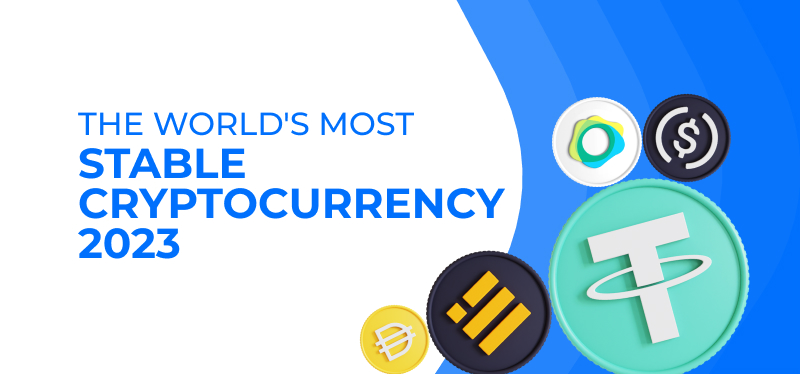The world’s most stable cryptocurrency

Key Takeaways
-
Stablecoins are gaining popularity in the cryptocurrency realm due to their ability to provide stability in value by pegging it to assets like the US dollar, gold, or a basket of currencies. This stability addresses the volatility concerns associated with other cryptocurrencies, making them more appealing for everyday use.
-
Stablecoins not only offer a safer means of using cryptocurrency but also enhance its usability as a medium of exchange and a store of value. Beyond that, stablecoins open up new frontiers in finance, presenting opportunities for investment and innovation without the inherent risks of volatile assets.
-
The five most stable cryptocurrencies for 2024 include Tether (USDT), USDC, Binance USD (BUSD), DAI, and Paxos Standard (PAX).
Stablecoins are the new trend in the world of cryptocurrency, and if you’re a tech-savvy geek, you need to know all about them.
Cryptocurrency is great and all, but let’s face it, its wild price swings can be a little intimidating. This is where stablecoins come in. They offer a solution to the issue of price volatility by pegging their value to a stable asset like the US dollar, gold, or a basket of currencies. This means that their price stays stable and doesn’t experience the dramatic ups and downs that you might see with other cryptocurrencies.
So why should you care about stablecoins? Well, for one, they make it easier to use cryptocurrency as a medium of exchange and a store of value. When you know that your money won’t lose its value overnight, you can feel more comfortable using it in your everyday life. This is especially true for people who are just starting to explore the world of cryptocurrency and aren’t ready to dive headfirst into the volatility of other coins.
But stablecoins are more than just a safer way to use cryptocurrency. They are also a new frontier in the world of finance, offering a variety of new opportunities for investment and innovation. With stablecoins, you can get exposure to the potential for growth in the crypto market, without having to worry about the risks associated with the volatility of other coins.
So if you’re one of those tech-savvy folks, stablecoins are definitely something you need to keep on your radar. They are the future of finance, offering stability, security, and new opportunities for growth.
Advantages of Stablecoins
Price Stability: The most notable advantage of stablecoins is their price stability, as they are pegged to a stable asset like the US dollar, gold, or a basket of currencies. This makes them more suitable for use as a medium of exchange and a store of value, as their value does not experience the wild price swings seen in other cryptocurrencies.
Increased Usability: Stablecoins offer increased usability compared to other cryptocurrencies, as they can be used in everyday transactions without worrying about the risk of price fluctuations.
Access to Crypto Market: Stablecoins provide access to the potential for growth in the crypto market, without having to worry about the risks associated with the volatility of other coins.
Decentralized: Stablecoins are decentralized, meaning that they are not controlled by any central authority. This provides a level of independence and security, as well as enabling faster and cheaper transactions compared to traditional financial systems.
High Liquidity: Stablecoins can have high liquidity compared to other cryptocurrencies as they are widely used and accepted.
Disadvantages of Stablecoins
Dependence on Peg Asset: Stablecoins are dependent on the stability of the asset they are pegged to. If the peg asset experiences a major drop in value, it could negatively impact the stability.
Regulation: Stablecoins are still a relatively new and unregulated asset class, which can make them subject to legal and regulatory uncertainty. This could limit their adoption and impact their value.
The world’s most stable cryptocurrency 2024
Here are the top 5 most stable cryptocurrencies for 2024:
1. Tether (USDT): Tether is one of the largest and most widely used stablecoins, pegged to the US dollar. It has a market capitalization of over $68 billion and high liquidity, making it a popular choice for investors.
2. USDC: USDC is a stablecoin pegged to the US dollar, issued by the CENTRE consortium, which is backed by Circle and Coinbase. It has strong transparency, security, and regulatory compliance measures in place, making it a safe and reliable investment option.
3. Binance USD (BUSD): Binance USD is a stablecoin pegged to the US dollar and issued by Binance, one of the largest cryptocurrency exchanges in the world. It offers fast and efficient transactions and has a strong reputation, making it a solid investment option.
4. DAI: DAI is a decentralized stablecoin that is pegged to the US dollar, but is not backed by a central authority. Instead, it is maintained by a decentralized network of users and smart contracts. It offers increased decentralization and security, making it a unique investment option.
5. Paxos Standard (PAX): Paxos Standard is a stablecoin pegged to the US dollar, issued by the Paxos Trust Company. It offers fast and efficient transactions and has strong regulatory compliance measures in place, making it a reliable investment option.
Varieties of Stablecoins
Types of Stablecoins: Stablecoins come in various forms, catering to different preferences and needs within the crypto community. Some are fiat-backed, pegged to traditional currencies like the US dollar, while others are algorithmic, relying on smart contracts and algorithms to maintain stability. Popular stablecoins include USDC, USDT, and DAI, each offering a unique approach to achieving price stability.
Algorithmic Stablecoins: Algorithmic stablecoins, such as DAI, stand out for their decentralized nature. Unlike fiat-backed stablecoins that rely on reserves, algorithmic stablecoins use smart contracts and decentralized mechanisms to manage their supply and demand dynamically. This approach aims to maintain stability without relying on external reserves, providing an alternative model for those seeking decentralization.
Fiat-Backed Stablecoins: Fiat-backed stablecoins, like USDC and USDT, are directly pegged to traditional currencies. These stablecoins maintain their value by holding reserves of the pegged currency in a secure manner. This ensures that for every stablecoin in circulation, there is an equivalent amount of the fiat currency held in reserve, assuring users of the stability of their holdings.
Crypto-Backed Stablecoins: In addition to fiat-backed and algorithmic stablecoins, there are crypto-backed stablecoins. These stablecoins are collateralized by other cryptocurrencies, providing a bridge between the crypto world and traditional financial stability. Users can lock up a certain amount of cryptocurrency as collateral to mint a corresponding value of stablecoins.
TrueUSD (TUSD): TrueUSD, pegged to the US dollar, is another notable stablecoin. It distinguishes itself by maintaining full collateralization, ensuring that each TUSD in circulation is backed by an equivalent amount of US dollars held in escrow. This commitment to transparency and collateralization enhances the stability and reliability of TrueUSD.
General information
Blockchain Technology: The backbone of stablecoins, like all cryptocurrencies, is blockchain technology. This decentralized and distributed ledger ensures transparency, security, and immutability. Blockchain enables the issuance, transfer, and verification of stablecoins in a trustless environment, removing the need for intermediaries and providing users with direct control over their assets.
Future Prospects: Stablecoins continue to evolve, offering solutions to the challenges of volatility in the cryptocurrency space. As the regulatory landscape matures, stablecoins are likely to play an increasingly crucial role in global finance. Their potential for mass adoption as a means of payment, a store of value, and a bridge between traditional and digital finance positions them as a cornerstone in the broader ecosystem.
Challenges and Considerations: While stablecoins offer numerous advantages, it’s essential to acknowledge the challenges and considerations associated with their widespread adoption. One critical factor is the potential impact of regulatory developments. As stablecoins gain popularity, governments worldwide are examining their regulatory stance, introducing uncertainties that could affect their use and value.
Moreover, the dependency on the stability of the peg asset, whether fiat currency or other cryptocurrencies, raises concerns. If the underlying asset experiences unexpected fluctuations, it could compromise the stability of the entire stablecoin ecosystem, emphasizing the importance of robust risk management strategies.
High Volatility and Crypto Assets: Despite stablecoins mitigating the volatility seen in other cryptocurrencies, the broader crypto market remains subject to high volatility. Investors and users should remain vigilant about the potential impact of market fluctuations, as stablecoins, while stable within their own framework, can be influenced by external market dynamics.
Crypto-backed stablecoins, in particular, introduce an additional layer of complexity, as the collateralized cryptocurrencies may experience price swings. This interdependence emphasizes the need for a comprehensive understanding of the broader crypto market for those considering stablecoins as part of their portfolio.
Evolution of Stablecoin Technology: As technology advances, the evolution of stablecoin mechanisms continues. Innovations in algorithmic stablecoins, smart contract capabilities, and decentralized finance (DeFi) protocols contribute to the ongoing refinement of stablecoin models. Staying informed about these technological developments is crucial for those keen on leveraging stablecoins effectively.
Rise of Decentralized Finance (DeFi): Stablecoins play a pivotal role in the flourishing landscape of decentralized finance. With decentralized lending, borrowing, and trading platforms gaining traction, stablecoins serve as a crucial medium for users to engage in various financial activities without exposure to the volatility associated with non-stable cryptocurrencies.
Integration into Everyday Life: The integration of stablecoins into everyday life is becoming more tangible. From online purchases to remittances, stablecoins provide a reliable means of transacting in the digital realm. As user-friendly platforms and applications continue to emerge, the practical use of stablecoins is likely to expand, contributing to a broader acceptance of digital currencies.
Conclusion
Stablecoins are a new form of digital money driven by an algorithm. Their low volatility makes them a suitable store of value and favors their use in everyday transactions. There is no doubt that stablecoins will play a key role in the global financial system as they effectively enable the practical use of cryptocurrencies.
It is safe to say that stablecoins have become an important component of the cryptocurrency market, and their opportunities and prospects are promising.
How do Stablecoins maintain price stability?
Stablecoins maintain price stability by pegging their value to a stable asset at a fixed exchange rate. This can be achieved through various mechanisms, including holding reserves of the pegged asset, algorithmic control, or a combination of both. The goal is to ensure that the value of the stablecoin closely tracks the value of the chosen stable asset, reducing the risk of significant price fluctuations.
What advantages do Stablecoins offer over traditional cryptocurrencies?
Stablecoins address the volatility concerns associated with traditional cryptocurrencies, making them more suitable for everyday transactions and as a store of value. They provide increased usability, as users can transact without worrying about the wild price swings seen in other cryptocurrencies. Additionally, stablecoins offer a gateway to the crypto market’s potential for growth without exposing users to the risks associated with highly volatile assets.
Are Stablecoins decentralized?
Yes, many stablecoins are designed to be decentralized. Decentralization means that these digital assets operate on blockchain technology without the control of a central authority. While some stablecoins, like DAI, operate in a decentralized manner, it’s important to note that others may have varying degrees of centralization, depending on their design and underlying infrastructure.
How can I use Stablecoins in everyday transactions?
Using stablecoins in everyday transactions is straightforward. Many cryptocurrency exchanges and online platforms accept stablecoins for payments. You can transfer stablecoins to others, use them for online purchases, or even participate in decentralized finance (DeFi) applications. Due to their stable value, stablecoins provide a reliable means of conducting transactions and holding value in the rapidly evolving world of digital assets.







